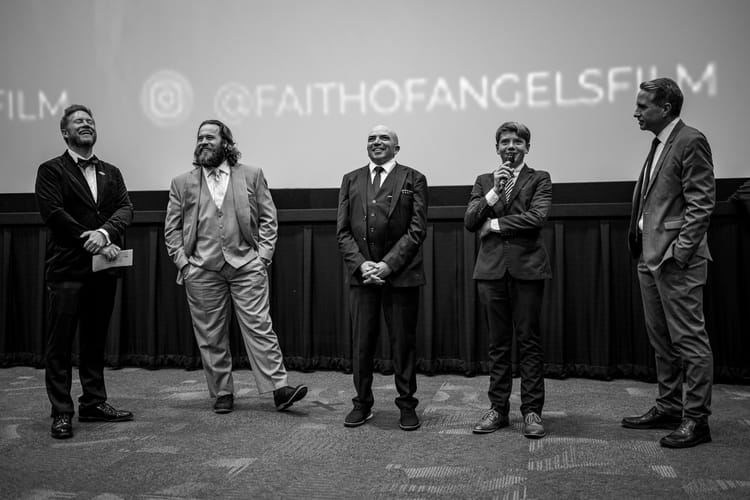The New Patrons of the Indie Film Industry

Here’s a statistic you’re not ready for: an $84 trillion wealth transfer will occur over the next 20 years. The Boomer generation (1946-1964) will represent over $53 trillion, the rest from the Silent generation (1928-1945).
What does this mean? Each generation isn't just transferring money; they're transferring their role as cultural guardians. They're seeking filmmakers who understand their distinct vision for what stories deserve to be preserved, amplified, or created. Many savvy entrepreneurs are buying up boomer businesses, but for us filmmakers, it means understanding that each generation guards culture differently and seeks different stewardship partners.
Each week, I’m speaking with boomer investors and Gen X and Z filmmakers. The difference is striking. Boomer investors care about who they’re investing in as much, if not more, than what they’re investing in. Many want to enter this industry because they see the connection movies provide with their families. They want shared experiences that are safe, uplifting, and spark conversation.
Here's the uncomfortable truth filmmakers refuse to acknowledge: your passion for a project has almost no correlation with its fundability. I see this weekly as I speak with filmmakers who've spent years developing scripts they're passionate about, only to discover that passion doesn't equal profit, and personal vision doesn't equal viable investment.
Younger filmmakers are passionate and resourceful, yet struggle to connect with investors due to niche or graphic content. 80% of the scripts people have asked to send me are horror-thriller, with graphic violence, rape, and language. While many cite Terrifier 3 as proof of a hungry audience, that film is an outlier, and horror is often the third to fifth most popular genre yearly.
The mistake is thinking that artistic integrity requires commercial suicide. The most successful independent filmmakers I know have learned to reverse-engineer their passion. They start with what each type of cultural patron wants to guard and preserve, then find ways to tell meaningful stories within those parameters.
The old rules of film financing are dying with the old guard. As the boomer studio heads retire and hand over the reins, a new industry will be created by today’s Millennial “Nomads,” built on pragmatism and resourcefulness.
Understanding these generational shifts is essential for survival in this industry.
The Boomer Legacy Play: Stewardship Over Speculation
Boomers are now in their wealth consolidation and legacy building phase. They’ve had successful businesses, are ready to retire, and have set themselves and their loved ones up for future success.
I’ve talked to many investors who referenced the “boring” and “unimpactful” businesses they built and the investments that grew their wealth. They are looking for other investment areas to bring meaning to their money.
Yes, many are interested in the tax-advantaged benefits of film and other investments, but that isn’t the driving force. Many filmmakers mistakenly think that adding a “Section 181” or “Donate Here” section on their pitch deck or website will turn on the money spigot.
These savvy investors have grown their money by avoiding get-rich-quick schemes. They seek entrepreneurs and filmmakers with a proven track record of success in making the films they want to invest in.
Think of the grandparent who can bring their entire multi-generational family to the film premiere with their name in the opening credits. That’s legacy, preserved for generations.
Filmmakers must understand these nuances and speak their language. This isn’t a creative project; it’s an opportunity to conserve and grow their wealth, leave a legacy, and have an impact. There must be a proven business model and conservative projections. Language like “cultural stewardship” and “lasting impact” has more influence than “10x return on investment” or the amount of passion you bring to the pitch.
In my book, Blockbuster, I showed how a filmmaker friend went from a $150,000 commitment from one investor to a $1M investment by changing the business model and the language he used when presenting the project. This shift changed our focus from “how will we raise the rest of the money” to a greenlight in days.
Gen X: The System Rebuilders
I’m putting a lot of emphasis and responsibility on my generation (I’m a Xennial) because of Fourth Turnings. The “Hero” generation in a fourth turning brings pragmatism, skepticism, resilience, resourcefulness, and independence to society.
Now we can apply it to film investing.
As system rebuilders, we want to build better institutions from scratch, not reform broken ones. We distrust the studio system and streaming giants because we have watched them systematically extract all the profit and upside from creators, leaving filmmakers to strike for a living wage.
Our political institutions are broken. We want change, equity, and a better system that takes care of everyone. We are seeking filmmakers aligned with creating a new ecosystem.
Gen X pragmatists will build the institutions that emerge from this Fourth Turning, so we're actively identifying filmmakers building sustainable, creator-owned models instead of complaining about the current system.
The Millennial Collective: The Movement Makers
Millennials are movement makers. They see every film investment as an opportunity to catalyze broader cultural change. Many of these new models, from crowdfunding to investment clubs to fan-owned studios, have been developed and are led by Millennials.
They are values-based filmmakers, obsessed with alignment between the storyteller and the audience. They want to be part of something bigger.
Unlike other generations who invest based on financial projections, Millennials want transparency throughout the entire process from development to distribution. They expect regular communication, shared decision-making, and clear metrics on cultural impact, not just financial returns.
If you’re a millennial filmmaker, emphasize the cultural change your films will create. Show how the project creates opportunities for community involvement and support. Provide regular updates and behind-the-scenes access so supporters feel part of the process. Frame the investment as participation in a movement the investor is passionate about.
A recent example is a documentary collective I know that raised $300,000 from Millennial investors. They did this not by promising huge returns, but by offering co-producer credits, monthly video updates, and community screenings in the filming cities. The investors became project evangelists, driving additional funding and distribution opportunities.
At a recent local festival, I saw some of the most exciting projects from Millennial filmmakers deeply embedded in a community, who spoke their language and understood the power of story.
The Gen Z Wild Card: The Platform Natives
Gen Z operates as platform natives. They don't distinguish between creating content and building businesses. They're entering their prime earning and investing years, and they're reshaping film project funding because they understand that audiences, revenue, and distribution can be built simultaneously rather than sequentially.
With Gen Z getting their reps in, it makes sense that they’re comfortable with smaller, more frequent investments. They’rehoning their craft through documentaries, short films, and music videos. They’re discovering their style and taste and learning the necessary tools that help them achieve it.
This generation understands viral content and algorithms better than anyone. If used properly, having them on your team is a valuable asset. They’re comfortable with equity crowdfunding, NFT-based film financing, and other digital-native investment vehicles that older generations find confusing or risky. They’ve seen individual creators build media empires (Mr. Beast, Taylor Swift) and aspire to do the same. Don’t hold them back, invest in them, as they are driven by analytics and social proof and have a better tap on what’s working than any older generation.
As platform natives, their value isn't just capital; it's integrated distribution. They bring built-in audiences and social media amplification that can increase a project's reach without additional marketing spend, making their smaller investments disproportionately valuable.
The Multi-Generational Pitch Strategy
Successful filmmakers will master the art of speaking each generation's investment language, rather than appeal to everyone. Here's your concrete framework:
- Lead with the generation most aligned with your project.
- Adapt your presentation materials for each generation's preferred formats.
- Structure deals that appeal to different generational motivations.
- Build investor relationships that honor generational communication preferences.
There is specific advice for dealing with different generations. Boomers prefer in-person meetings, printed materials, phone calls, and a personal touch. Gen X appreciates async communication like email, detailed business plans, and direct communication. Millennials need shared documents, video calls, and regular updates. Gen Z values social media engagement, mobile-first materials, and quick decisions.
If you’ve raised money for a film, you know these stereotypes are true. They reflect generational differences that many filmmakers ignore.
This isn’t about pandering to different groups. It’s about matching the right projects with the right patrons and partners.
Filmmakers who master this multi-generational approach will dominate in the next 20 years and emerge from this crisis era ahead.
The Path Forward
The great wealth transfer isn't just about money; it's about values, priorities, and cultural influence shifting between generations. Filmmakers who understand this shift and position themselves accordingly won't just survive the current industry upheaval; they'll emerge as the new power brokers.
Today, you can audit your investor relationships, identify missing generations, and create a plan to connect with them as investors or collaborators.
This generational lens isn't just theory. It's the roadmap for the next phase of independent film financing. The question isn't whether these patterns will hold, but whether you'll benefit from them.
Next Chapter








Member discussion